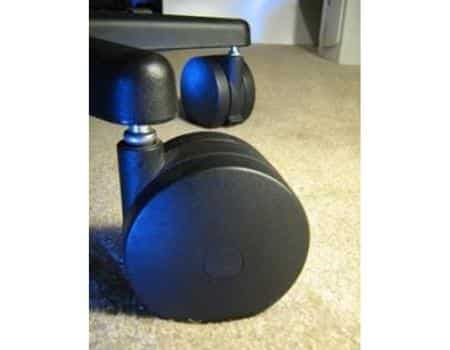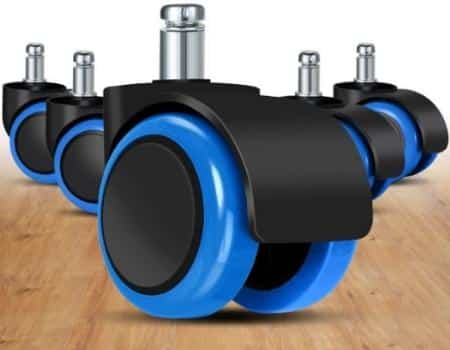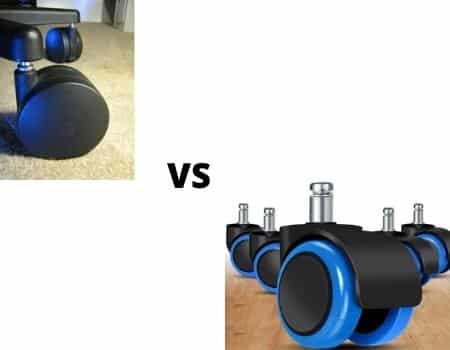Have you ever wondered the difference between carpet casters and hard floor casters? The carpet casters vs hard floor casters would let you know it! Casters for floor carpets and casters for hardwood floors may look similar but differ in one key feature: the wheel’s strength.
One simple sixth rule for choosing casters for a particular flooring item is that caster wheel tread should be the opposite stiffness of the floor material. Think hard in a soft place and soft in a hard place.
It means that if you have a low carpet, you will want to consider solid tire materials such as steel or concrete, while for solid flooring, you will want to use soft treads such as soft rubber or polyurethane. An important choice of caster wheel tread can improve the efficiency of your caster while protecting the floor material you carry.
Carpet casters

For carpets, you are looking for casters with sturdy wheels to provide easy mobility and increase mobility. Materials such as cast iron, Polyolefin, iron, Urethane, hard synthetic, or nylon are good choices for good mobility while preventing damage to the carpet.
Hard floor casters

Casters with heavy treadmills can cause damage to woodworking quickly, which is why it is important to think about this before making your purchase.
If you buy the wrong caster unintentionally, you may quickly find that you have damaged the hardwood floor irreparably before you can repair the condition.
If you have solid wood floors, you should choose casts that incorporate soft tire materials such as soft rubber, Polyolefin, Nylon, Polypropylene, or Urethane.
These tire material options are great for keeping your hardwood floor undamaged while allowing for smooth movement and excellent grip.
Difference between carpet casters and hard floor casters

Carpet casters are softer than hard floor casters – much like a roller skate wheel than solid plastic – prevent them from slipping under you and damaging the floor.
They are best used for solid floorings such as wood or a plastic chair mat.
Some places call them soft casters because they are softer than standard plastic casters and some people call them hard floor casters because they are made for that kind of surface.
They mean the same thing, but they have different sentences. Many people buy soft seat chasers to protect their floor and save money instead of buying a chair mat.
Soft casts are usually specified in the chair you purchase. Soft Casters should be requested from the chair manufacturer, and it will take less time to deliver once you have purchased your seat.
Yes, carpet caster usually has extra cash (you will still get regular casters and soft caster if purchased at an additional cost).
The most important factor to consider when buying an office chair that is often overlooked is whether your chair will be used in a carpeted or solid environment such as wood, laminate, tile, or vinyl.
Modern office chairs have many options, arms or without arms, a normal lumbar or lumbar adjustable, and even a caster type.
Stable desk chairs are common in most chairs and are designed for carpeted floors; however, not all offices have carpets. If your floor is a solid surface such as solid wood, laminate, or tile, you will need soft casters on your seat.
Many people prefer to use a chair mat to protect their mat. Soft desk casters should also be used with sturdy plastic seat mats.
Soft casts are offered for a small fee, but sometimes there is no difference in price depending on the seat and the builder. But whether you are offering extra cash or not, it is best to have a soft caster if you use a chair in a tight place. Using hard casts on a solid surface is dangerous and will affect the life cycle of your chair.
Choosing the right caster
Choosing the right caster viz., soft carpet caster or hard floor caster has many consequences at that time. Ergonomics and occupational safety are essential to business productivity, and anxiety is not a reality in the home environment.
Along with estimating the cost of earning, it is important to understand the type of your floor, the working environment, the weather, and the strength of your load.
Floor Type:
A chair with a hard floor caster will move quickly on a solid floor and sometimes catch the worker by surprise, and the worker may find himself on the floor. You do not deserve the risk of employee injury and your company’s liability.
It is important to consider the type of flooring when choosing your seat options. Steelcase has a special site set up to help guide your choice of the caster.
We cover the type of floor in-depth as that drives the first decision people to experience when buying a caster.
Workplace:
Your workplace is another important decision in choosing a caster. Your choice of caster will be influenced by several factors like the level of aggression they will tolerate, what types of chemicals they may be exposed to and whether they will need to roll over in the trash or face rapid temperature changes during their performance.
The weather:
Weather is a factor that is often overlooked when determining which casters are best suited for a particular system.
When temperatures are relatively similar, the weather is not a major concern, but high temperatures affect which caster type is best suited for the job.
For example, cold temperatures in the arctic area can cause oil to freeze, thus shutting off bearings. The wrong kind of caster tread will be less cracked if it is cold enough.
Upload capacity:
A simple calculus is the only requirement for determining the minimum loading capacity required for each caster.
First, divide the large load you will be working on by the number of advertisers you expect to use. From there, you can determine the minimum load capacity you will need per caster: (weight/casters = Minimum load capacity per caster).
The load capacity also determines the degree of friction and temperature on the caster bearings. Regular use of moving heavy loads with insufficient distribution will lead to rapid failure of units due to excessive oil overheating and subsequent decay.
Conclusion:
Your workplace is another important decision in choosing a caster. Your choice of caster will be influenced by many factors, such as the level of aggression they will tolerate? Moreover, it is also important to consider what types of chemicals they may be exposed to and whether they will need to roll over in the trash or face rapid temperature changes during their performance.
Weather is a factor that is often overlooked when determining which casters are best suited for a particular system. Materials such as cast iron, Polyolefin, iron, Urethane, hard synthetic, or nylon are good choices for good mobility while preventing damage to the carpet.
Carpet casters are softer than hard floor casters – much like a roller skate wheel than solid plastic – prevent them from slipping under you and damaging the floor. They are best used for solid floorings such as wood or a plastic chair mat.

I’m Justin Allen, found of mychairreviews.com where I review gaming chairs, massage chairs, recliners for people who are looking to buy one. I love writing things on the internet and blogging about anything that interests me which is usually video games, technology, or sports-related items. When I am not working on blog posts or reviewing products I have a passion for you can find me playing video games with friends online!



